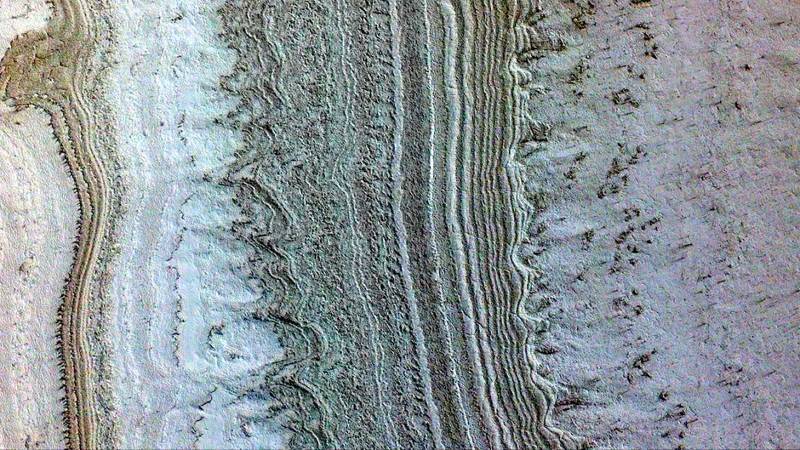In a groundbreaking study published in Communications Earth & Environment, researchers have uncovered the potential for photosynthetic life within the icy regions of Mars. This discovery challenges our understanding of the Red Planet’s habitability and could revolutionize the search for extraterrestrial life.
Summary: New research suggests that dusty ice on Mars could provide suitable conditions for photosynthetic life, with mid-latitude ice deposits identified as key areas for future exploration.
Estimated reading time: 6 minutes
The Martian Ice Conundrum
Mars, with its harsh surface conditions and high levels of ultraviolet radiation, has long been considered an inhospitable environment for life as we know it. However, the new study suggests that beneath the planet’s icy exterior, a different story may be unfolding.
Aditya Khuller and colleagues have developed a sophisticated model to investigate the possibility of “radiative habitable zones” within Martian ice. These zones represent areas where the ice is thick enough to shield potential life forms from harmful ultraviolet radiation while still allowing sufficient light for photosynthesis to occur.
Unveiling the Potential for Life
The researchers found that the composition and structure of Martian ice play crucial roles in determining the existence and location of these habitable zones. Their findings indicate that ice containing between 0.01% and 0.1% dust could potentially harbor life at depths ranging from 5 to 38 centimeters below the surface.
Interestingly, cleaner ice with less dust content could support even larger habitable zones, extending from 2.15 to 3.10 meters deep. This discovery opens up new possibilities for where life might exist on Mars and how we might detect it.
The Role of Dust in Martian Ice
Dust particles within the ice serve a dual purpose in this potential ecosystem. On one hand, they help absorb harmful ultraviolet radiation. On the other, they could facilitate the creation of liquid water through localized melting at depths of up to 1.5 meters.
The study suggests that while polar regions on Mars are likely too cold for this process, subsurface melting could occur in mid-latitude areas, between approximately 30 and 50 degrees latitude. This narrows down the search area for potential life on Mars and provides valuable guidance for future exploration missions.
Implications for Future Mars Exploration
The authors of the study are cautious in their conclusions, stating:
“The authors caution that the potential existence of theoretically habitable zones does not mean that photosynthetic life is, or has ever been, present on Mars.”
However, they also emphasize the significance of their findings for future Mars missions:
“It does suggest that the few instances of exposed ice in the Martian mid-latitudes could be key areas for future searches for life to focus on.”
This research could dramatically influence the planning of upcoming Mars missions, potentially shifting focus to these mid-latitude ice deposits as prime targets for the search for extant life.
Challenges and Limitations
While the study presents exciting possibilities, it’s important to note the challenges involved in confirming these findings. The exact composition and structure of Martian ice remain uncertain, and the presence of liquid water – a key ingredient for life as we know it – is still theoretical in many of these environments.
Moreover, the extreme conditions on Mars, including low atmospheric pressure and temperature fluctuations, pose significant hurdles for the survival of any potential life forms.
Looking Ahead
As we continue to explore Mars and refine our understanding of its environment, studies like this one provide valuable guidance for where to focus our efforts. The potential for life in Martian ice deposits not only expands our search parameters but also challenges our perceptions of where life can exist in the universe.
Future missions to Mars may now prioritize investigating these mid-latitude ice deposits, equipped with instruments specifically designed to detect signs of life in these unique environments. As we push the boundaries of our knowledge, we may find that life, in its tenacious and adaptable nature, has found a way to thrive in the most unexpected places – even in the icy depths of our neighboring planet.
Quiz: Test Your Knowledge on Martian Ice and Potential Life
- According to the study, what percentage of dust in Martian ice could potentially support life? a) 1-2% b) 0.01-0.1% c) 5-10% d) >1%
- At what depths could habitable zones exist in cleaner Martian ice? a) 5-38 cm b) 1-2 m c) 2.15-3.10 m d) 10-20 m
- Which regions on Mars are suggested as potential areas for subsurface melting? a) Polar regions b) Equatorial regions c) Mid-latitude areas (between 30-50 degrees) d) Global ice caps
Answer Key:
- b) 0.01-0.1%
- c) 2.15-3.10 m
- c) Mid-latitude areas (between 30-50 degrees)
Glossary of Terms
- Radiative habitable zone: An area within ice where harmful UV radiation is blocked, but enough light penetrates for photosynthesis.
- Photosynthetically active radiation (PAR): Light wavelengths used by organisms for photosynthesis.
- Cryoconite: Dark dust or sediment on ice that absorbs solar radiation and can create melt holes.
- Firn: Compacted snow that is transitioning to glacial ice.
- Solar zenith angle: The angle between the sun and the point directly overhead.
- Actinic flux: The total light available from all directions, relevant for photosynthesis in ice environments.
Enjoy this story? Get our newsletter! https://scienceblog.substack.com/

























































